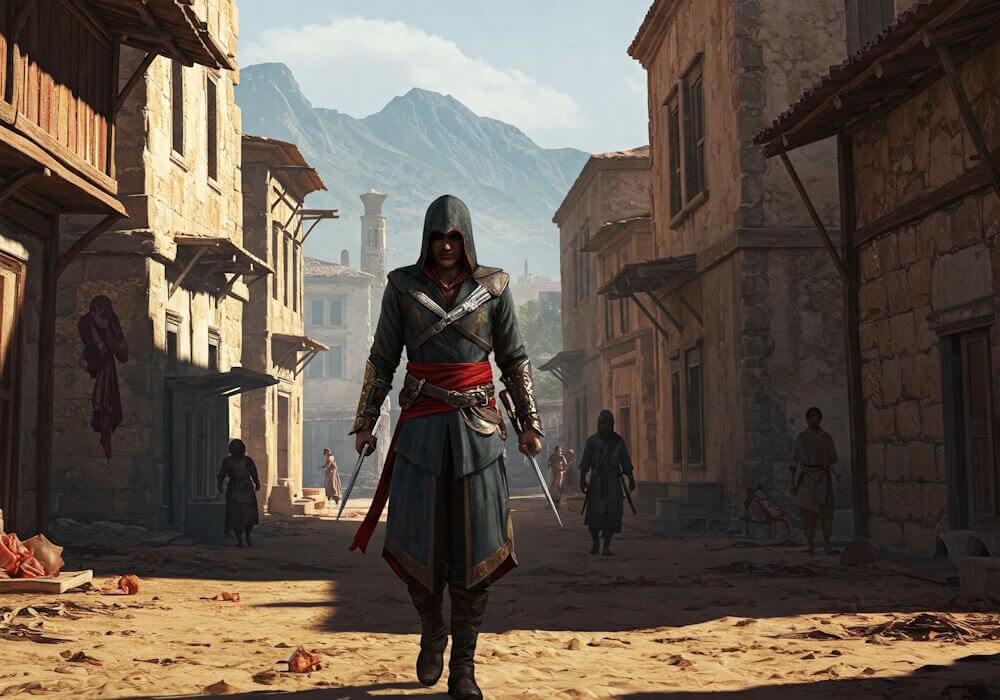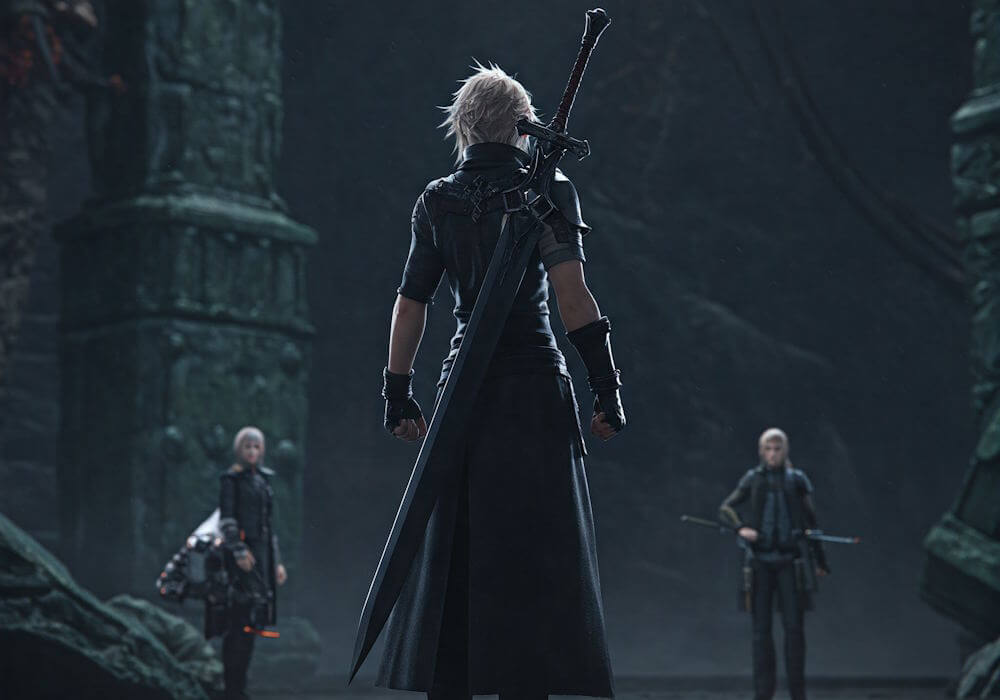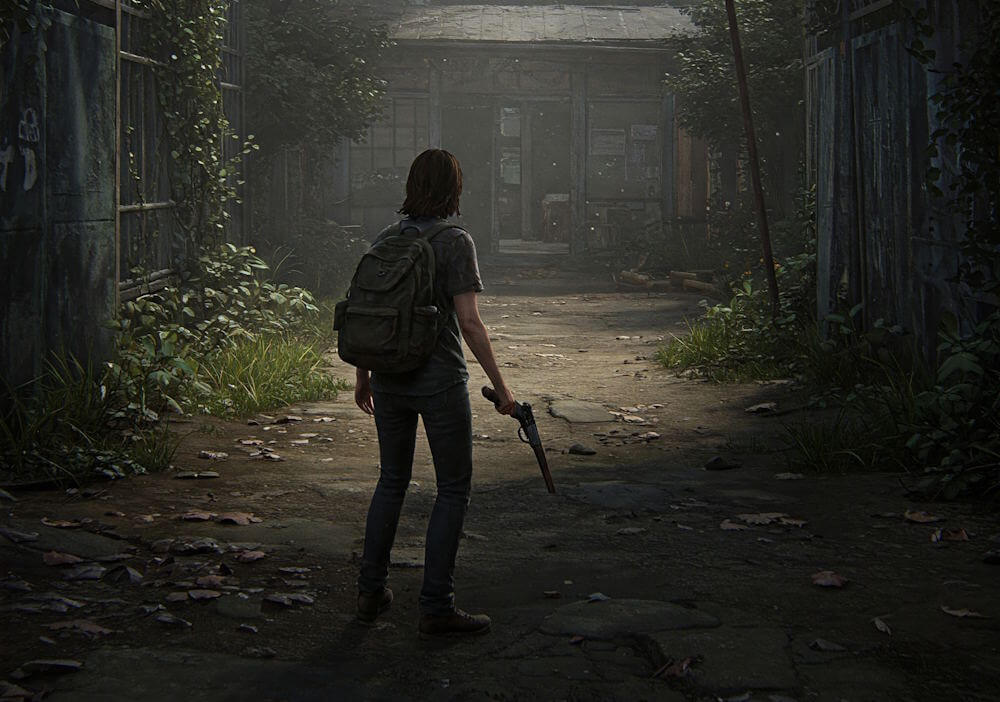Assassin’s Creed Mirage represents a significant chapter in the esteemed Assassin’s Creed franchise, heralding a return to the series’ classic roots. Developed by Ubisoft, this installment is set in a richly detailed historical context, specifically in Baghdad during the ninth-century, allowing players to immerse themselves in a vibrant, dynamic world filled with cultural nuances and historical significance. The game emphasizes the series’ hallmark elements, such as fluid parkour maneuvering and stealth-based gameplay, reminiscent of earlier titles adored by long-time fans.
The storyline centers on Basim Ibn Ishaq, a cunning thief with a mysterious past, who eventually becomes embroiled in the age-old conflict between the Assassins and the Templars. As players navigate through various quests and challenges, they will uncover Basim’s journey of self-discovery and his pivotal role in the fabric of Assassin’s Creed lore. This narrative focus not only enriches the gameplay but also aims to elevate the emotional investment for players, making their experiences even more immersive.
One of the key aspects that adds to the excitement surrounding Assassin’s Creed Mirage is its commitment to a streamlined gameplay experience, stripping away some of the more convoluted mechanics introduced in recent releases. This intentional design decision aims to rekindle the simplicity and elegance that characterized earlier Assassin’s Creed titles, making it accessible for newcomers while simultaneously catering to veteran players who long for the essence of classic gameplay.
The anticipation for Assassin’s Creed Mirage has been palpable within the gaming community, with many expressing excitement over its dedication to core mechanics while still providing fresh narratives and stunning graphics. As such, this game stands poised not only to revitalize the franchise but also to reaffirm its position as a pioneer in the action-adventure genre.
The Evolution of Parkour in Assassin’s Creed
The Assassin’s Creed series has long been synonymous with the fluidity and thrill of parkour mechanics, offering players an immersive experience as they navigate sprawling urban landscapes and historical settings. The introduction of free-running mechanics in the original game, released in 2007, marked a revolutionary shift in video game design. Players were given unprecedented freedom to traverse environments, scaling rooftops and executing seamless transitions between running, climbing, and jumping. This blend of agility and strategy enabled players to embody the agile assassins they portrayed, making parkour a defining characteristic of the franchise.
As the series progressed, the parkour mechanics saw iterative changes. In “Assassin’s Creed II,” the introduction of contextual actions allowed for a more intuitive control scheme, enhancing player engagement by reducing the number of inputs required for intricate movements. However, subsequent entries, such as “Assassin’s Creed III” and “Assassin’s Creed IV: Black Flag,” began to emphasize a more open-world structure, integrating naval exploration and additional gameplay elements that sometimes overshadowed the core parkour experience. While these innovations expanded the gameplay scope, they also led to a dilution of the parkour mechanics that originally captivated audiences.
With the recent announcement of “Assassin’s Creed Mirage,” there is a renewed focus on returning to classic parkour mechanics. The developers have explicitly stated their intention to recapture the essence of traversal that defined the franchise’s roots. By reinstating the intuitive design and fluid dynamics, “Mirage” aims to deliver a parkour experience that resonates with both veteran players and newcomers, rekindling the excitement and engagement that initially drew players into the beautifully crafted world of Assassin’s Creed.
Key Features of Classic Parkour in Mirage
In the highly anticipated title, Assassin’s Creed Mirage, the developers have taken significant steps to reintroduce the quintessential elements of classic parkour that fans have come to love. One of the standout features is the enhanced fluidity and realism of character movements. This improved mobility extends beyond mere aesthetics; it ensures that players experience a seamless and immersive traversal of the environment, embodying the spirit of a true assassin as they navigate rooftops, narrow ledges, and intricate alleyways of the vibrant cityscape.
Another defining characteristic of classic parkour in Mirage is the revival of iconic traversal mechanics, which include features like the ability to vault over obstacles, slide under barriers, and rapidly change directions mid-jump. Players can execute these movements with an unprecedented level of precision, reflecting a commitment to creating an action-oriented gameplay experience. These mechanics make it possible for characters to interact dynamically with their surroundings, allowing for spontaneous explorations and exhilarating escapes.
Furthermore, the incorporation of environmental elements has been meticulously designed to promote the use of parkour techniques. Urban environments are populated with various structures and surfaces that encourage players to experiment with different routes, fostering creativity in navigation. The game’s architecture is intentionally crafted to support players’ playstyles, ensuring that every jump, climb, and sprint is not only gratifying but also strategically significant, contributing to the overall mission objectives.
The focus on classic parkour in Assassin’s Creed Mirage underscores a return to the series’ roots, allowing for a gameplay experience that is both nostalgic and fresh. By blending these core elements with modern enhancements, players are offered a truly engaging path through the historical settings that define the franchise. This harmonious integration of fluid movement and tactical exploration marks a pivotal evolution in the series, promoting a rich and immersive player experience.
Character Design and Development: The Protagonist’s Role
In the realm of video games, character design plays a crucial role in capturing the audience’s attention and importance, especially in franchise such as Assassin’s Creed. Within Assassin’s Creed Mirage, the protagonist is designed not only with an intricate backstory but also with abilities that reflect the game’s return to classic parkour mechanics. Players encounter a character whose skills resonate with the stealth and parkour dynamics reminiscent of earlier titles in the series. This character emphasizes fluid movement and agility, allowing for a seamless gameplay experience that harkens back to the roots of the franchise.
The protagonist’s design is marked by unique visual aesthetics and a compelling narrative that intertwines with the gameplay mechanics. Their appearance often highlights elements that signify their expertise in stealth and agility, such as light armor that allows for unhindered movement. This design choice ensures that players feel a strong sense of connection with the character’s abilities, allowing them to embody the elusive nature of an assassin. Furthermore, the development of this character involves not just physical traits, but also emotional depth, engaging players through their personal journey and motives that unfold throughout the game.
Additionally, the skills unique to the protagonist enhance gameplay by encouraging players to explore parkour as a core mechanic. The emphasis on traversing complex environments with agility and finesse rekindles the classic parkour experience. The integration of these abilities allows for a variety of approaches to objectives, from stealthy infiltration to daring escapes, all crucial components of the game’s design. Such character-centric design elements not only foster immersion but also promote a deeper understanding of the challenges faced by the protagonist against a richly crafted backdrop. This attention to detail ensures that players are not just maneuvering through levels but experiencing a narrative that enhances their overall gameplay experience.
Environmental Design: Urban Landscape and Verticality
‘Assassin’s Creed Mirage’ marks a significant shift back to the core mechanics that originally defined the franchise, particularly emphasizing parkour within its urban landscapes. The game’s design meticulously interweaves verticality into the crafted environments, allowing players to navigate the richly detailed city with agility. Drawing inspiration from real-world architecture, its urban settings are infused with large structures and intricate alleyways that create a dynamic playground for traversal.
The environmental design of ‘Assassin’s Creed Mirage’ is pivotal in promoting vertical exploration. Streets are filled with towering buildings, rooftops, and overhangs that not only showcase the impressive architecture of Buenos Aires but also create multiple paths for players. This fosters a level of exploration that feels organic, where players can choose to take the rooftops or venture down into the alleyways below. The inclusion of elements such as ledges, windows, and balconies encourages parkour maneuvers, enhancing the fluidity of movement as players leap, climb, and slide through the landscape.
Game Mechanics: Stealth and Combat Integration
In ‘Assassin’s Creed Mirage’, the integration of parkour mechanics with stealth and combat systems plays a pivotal role in shaping the overall gameplay experience. The game returns to its roots, emphasizing the fluidity of movement and the strategic elements that characterized earlier titles in the franchise. Players are invited to traverse expansive environments by seamlessly transitioning between parkour and stealth tactics, allowing them to engage with the world in a more immersive manner.
The parkour system is designed to facilitate dynamic navigation through urban landscapes, enabling players to climb buildings, leap across rooftops, and evade pursuers. This mobility not only enhances exploration but also serves as a critical component in executing stealth strategies. For instance, players can use parkour to access elevated vantage points, from which they can survey enemies and identify strategic approaches. Moreover, these high ground advantages make it easier to blend into the environment, offering opportunities for ambush or escape.
Combat mechanics in ‘Assassin’s Creed Mirage’ are intricately linked to the core principles of stealth and parkour. Players can utilize their agility to maneuver around opponents, allowing for quick evasion and counterattacks. This agility reinforces a tactical gameplay style where timing and positioning are essential. Engaging enemies directly may not always be the best approach; therefore, players are encouraged to utilize their surroundings effectively, whether it be using parkour elements to retreat or to position themselves advantageously during skirmishes.
The successful combination of these mechanics fosters a gameplay loop where players must constantly assess their environment and adapt their strategies accordingly. This balance ensures that player choices significantly impact outcomes, promoting a blend of action and thoughtfulness that enhances the overall experience. In ‘Assassin’s Creed Mirage’, mastering the art of parkour, stealth, and combat integration is essential for overcoming the diverse challenges within the game.
Player Feedback: Balancing Nostalgia and Innovation
Assassin’s Creed Mirage has prompted a wave of reactions from both long-time fans of the franchise and newcomers drawn to its enhanced mechanics. The game’s decision to return to classic parkour has been met with enthusiasm amongst veteran players who fondly remember the fluid movement systems of the early installments. These players have expressed gratitude for the return of a more traditional approach to traversal, reminiscent of the gameplay experiences that defined the series for many years. This revival of classic parkour elements has sparked feelings of nostalgia, recalling the exhilarating moments of climbing and leaping through historical landscapes.
However, the reception is not unanimous, as newer players might expect innovations that align with contemporary gaming standards. Feedback has indicated that while innovative mechanics are integral to modern gaming, the return of classic parkour allows for a blend of old and new gameplay experiences. Some critics argue that the developers have managed to maintain a balance that integrates advanced techniques without fully sacrificing the charm of the original system. Players appreciate the integration of new features alongside the nostalgic aspects, which enables both groups—long-time fans and newcomers—to enjoy the game.
The dialogue surrounding this game reveals a spectrum of expectations; while nostalgia plays a pivotal role in attracting seasoned players, the incorporation of innovative elements is essential for engaging a younger audience. Ultimately, the success of Assassin’s Creed Mirage lies in its ability to weave these two aspects together seamlessly. The challenge of balancing nostalgia with innovation remains a focal point of discussion among fans, influencing the overall perception of the game’s parkour mechanics. This confluence of varying expectations showcases the evolution of the franchise while remaining respectful to its roots.
Future of the Franchise: What Comes Next?
The release of ‘Assassin’s Creed Mirage’ signifies a pivotal moment for the franchise, as it seeks to reconnect with its roots by reintroducing classic parkour and stealth mechanics that originally defined the series. This shift towards nostalgia raises several questions regarding the future trajectory of the franchise. Will this return to classic gameplay be a one-time event, or could it herald a broader transformation in how subsequent titles are crafted?
The implications of ‘Mirage’ extend beyond nostalgia; they may indicate a strategic pivot aimed at re-engaging long-time fans disillusioned by recent iterations. By emphasizing the core elements of parkour and stealth, Ubisoft appears to be acknowledging feedback from the player community, suggesting a willingness to adapt the franchise in response to audience expectations. This approach could pave the way for future titles that more deeply explore the rich historical narratives and immersive environments that have long been hallmarks of the series.
Moreover, the potential success of ‘Assassin’s Creed Mirage’ could influence not only game mechanics but also the overall tone and structure of future games. If this installment is met with positive reception, it is plausible that Ubisoft may prioritize elements that foster exploration and player agency, moving away from the RPG-heavy format that has dominated the previous few releases. Such a change would signify a return to the series’ origins, where fluid movement and engaging, compact narratives were central to the player’s experience.
Ultimately, the path that ‘Assassin’s Creed’ will take remains uncertain. While ‘Mirage’ serves as a powerful reminder of the franchise’s foundation, it is crucial to observe how Ubisoft capitalizes on this opportunity. Whether this release signals a lasting change or stands as an isolated homage will only become clear as further titles emerge in the coming years.
Conclusion: The Legacy of Assassin’s Creed Mirage
Assassin’s Creed Mirage represents a significant moment in the evolution of the franchise, skillfully intertwining the rich history of parkour mechanics with contemporary gaming expectations. By placing emphasis on classic gameplay elements, this title not only pays homage to its predecessors but also revitalizes the core experience that long-time fans fell in love with. The return to a more streamlined parkour system evokes nostalgia, reminding players of the series’ roots while simultaneously ushering in innovative enhancements that broaden its appeal.
The narrative journey within Assassin’s Creed Mirage skillfully encapsulates the themes of legacy, honor, and the complex interplay of power in historical contexts. Players are invited to explore a meticulously crafted environment that reflects the intricate labyrinths of both architectural design and rich lore. This thoughtful combination ensures that the game resonates on multiple levels, catering to those who seek deep storytelling along with engaging gameplay. The impact of this title extends beyond individual experiences, reigniting discussions within the broader gaming community about the nature of progression in open-world design.
Furthermore, the game has the potential to influence future installments in the Assassin’s Creed series, emphasizing the importance of player agency and exploration. By prioritizing these elements, Ubisoft has demonstrated a commitment to fostering an engaging and immersive atmosphere that encourages players to forge their paths. As a result, Assassin’s Creed Mirage stands as both a tribute to the franchise’s storied past and a beacon for its future, emphasizing that while gaming evolves, the essence of adventure and discovery remains timeless. Ultimately, the legacy of Assassin’s Creed Mirage will be felt for years to come, sparking new interest and discourse within the realm of gaming.




